FDA Enrichment Strategies for Clinical Trials to Support Approval of Human Drugs and Biological Products
标准简介
Enrichment Strategies for Clinical Trials to Support Approval of Human Drugs and Biological Products[附网盘链接]是FDA发布的FDA标准,适用于美国。标准截图
![Enrichment Strategies for Clinical Trials to Support Approval of Human Drugs and Biological Products[附网盘链接]](/img/20210914103741qfoaf.jpg)
标准文档说明
标准文档类型为Enrichment Strategies for Clinical Trials to Support Approval of Human Drugs and Biological Products[附网盘链接]高清PDF版本(文字版),标准文档内可进行搜索,可以复制原文,可粘贴。标准部分原文
Enrichment Strategies for Clinical Trials to Support Determination of Effectiveness of Human Drugs and Biological Products 1
Guidance for Industry This guidance represents the current thinking of the Food and Drug Administration (FDA or Agency) on this topic. It does not establish any rights for any person and is not binding on FDA or the public. You can use an alternative approach if it satisfies the requirements of the applicable statutes and regulations. To discuss an alternative approach, contact the FDA office responsible for this guidance as listed on the title page. I. INTRODUCTION The purpose of this guidance is to assist industry in developing enrichment strategies that can be used in clinical investigations intended to demonstrate the effectiveness of drug and biological products. Enrichment is the prospective use of any patient characteristic to select a study population in which detection of a drug effect (if one is in fact present) is more likely than it would be in an unselected population. Although this guidance focuses on enrichment directed at improving the ability of a study to detect a drug’s effectiveness, similar strategies can be used in safety assessments. The enrichment strategies described in this guidance are intended to increase the efficiency of drug development and support precision medicine, i.e., tailoring treatments to those patients who will benefit based on clinical laboratory, genomic, and proteomic factors. This guidance also discusses design options for enrichment strategies and discusses the interpretation of the results of studies that use enrichment strategies. In general, FDA’s guidance documents do not establish legally enforceable responsibilities. Instead, guidances describe the Agency’s current thinking on a topic and should be viewed only as recommendations, unless specific regulatory or statutory requirements are cited. The use of the word should in Agency guidances means that something is suggested or recommended, but not required. 1
This guidance was developed by the Center for Drug Evaluation and Research in coordination with the Center for Biologics Evaluation and Research at the Food and Drug Administration. Although the principles and examples discussed in this guidance relate primarily to the safety and effectiveness of drugs and biologic products many of these principles also apply to studies for other medical products, including devices. FDA encourages a sponsor that is considering applying these principles to the study of a device to discuss such a proposal with the Center for Devices and Radiological Health, specifically with the organizational unit responsible for that product area.
网盘链接
百度网盘:https://pan.baidu.com/s/1unFMvADrsGnF2-XXl5JlMw
提取码:r4na
【温馨提示】大资料ISO是提供信息发布的专业信息类网站,所有内容均由用户发布,不代表本站观点,本站亦不存储所涉及的文件及资料。如有【免费资料】以及【付费资料】,请用户根据自己的需求,自行判断是否需要获取。如有交易诈骗、内容侵权可发送邮件至kf@dzl100.com,我们审查后若发现情况属实,会立即对相关内容进行删除处理。
加载用时:141.5837 毫秒
相关评论
相关文章
-
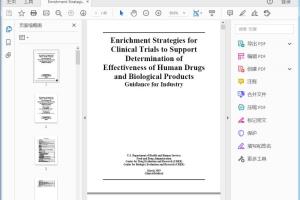
FDA Enrichment Strategies for Clinical Trials to Support Approval of Human Drugs and Biological Products
Enrichment Strategies for Clinical Trials to Support Approval of Human Drugs and Biological Products[附网盘链接]是FDA于不久之前发布的FDA标准,适用于美国。本次分享的标准文档为高清PDF(文字版),标准文档内可搜索,可复制,可粘贴。本文结尾附网盘链接。
-

FDA Control of Nitrosamine Impurities in Human Drugs Guidance for Industry
Control of Nitrosamine Impurities in Human Drugs Guidance for Industry[附网盘链接]是Food&Drug Administration于过去发布的FDA标准,适用于US。本次分享的标准文档为高清PDF(文字版),标准文档内可搜索,可复制,可粘贴。本文结尾附网盘链接。
-
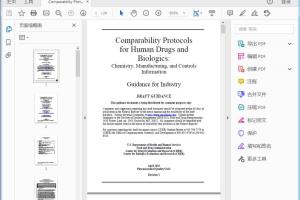
FDA Comparability Protocols for Human Drugs and Biologics Chemistry, Manufacturing, and Controls Information
Comparability Protocols for Human Drugs and Biologics Chemistry, Manufacturing, and Controls Information[附网盘链接]是FDA于不久前发布的FDA标准,适用于美国。本次分享的标准文档为高清PDF(文字版),标准文档内可搜索,可复制,可粘贴。本文结尾附网盘链接。
-
![CVM GFI #185 (VICH GL43) Target Animal Safety for Veterinary Pharmaceutical Products.pdf[网盘链接]](/img/small/20210914103659dm8zg.jpg)
CVM GFI #185 (VICH GL43) Target Animal Safety for Veterinary Pharmaceutical Products.pdf[网盘链接]
GFI #185 (VICH GL43) Target Animal Safety for Veterinary Pharmaceutical Products.pdf是于发布的标准,适用于。本次分享的标准文档为高清PDF(文字版),标准文档内可搜索,可复制,可粘贴。本文结尾附网盘链接。
-
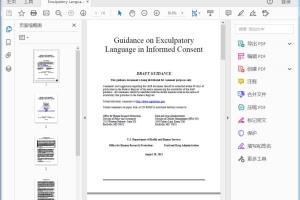
FDA Exculpatory Language in Informed Consent
Exculpatory Language in Informed Consent[附网盘链接]是FDA于不久前发布的FDA标准,适用于美国。本次分享的标准文档为高清PDF(文字版),标准文档内可搜索,可复制,可粘贴。本文结尾附网盘链接。
-

FDA Allowable Excess Volume and Labeled Vial Fill Size in Injectable Drug and Biological Products
Allowable Excess Volume and Labeled Vial Fill Size in Injectable Drug and Biological Products[附网盘链接]是Food And Drug Administration于不久之前发布的FDA标准,适用于US。本次分享的标准文档为高清PDF(文字版),标准文档内可搜索,可复制,可粘贴。本文结尾附网盘链接。
-
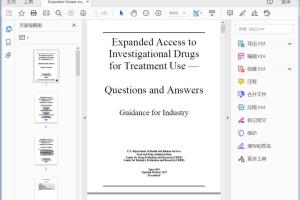
FDA Expanded Access to Investigational Drugs for Treatment Use - Questions and Answers
Expanded Access to Investigational Drugs for Treatment Use - Questions and Answers[附网盘链接]是Food&Drug Administration于不久前发布的FDA标准,适用于U.S。本次分享的标准文档为高清PDF(文字版),标准文档内可搜索,可复制,可粘贴。本文结尾附网盘链接。
-
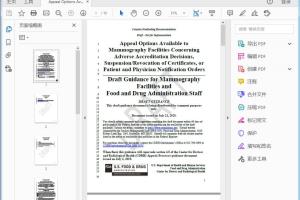
FDA Adverse Accreditation Decisions, SuspensionRevocation of Certificates, or Patient and Physician Notification Orders Draft
Adverse Accreditation Decisions, SuspensionRevocation of Certificates, or Patient and Physician Notification Orders Draft[附网盘链接]是Food And Drug Administration于不久之前发布的FDA标准,适用于United States。本次分享的标准文档为高清PDF(文字版),标准文档内可搜索,可复制,可粘贴。本文结尾附网盘链接。
-
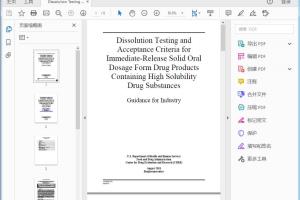
FDA Dissolution Testing and Acceptance Criteria for Immediate-Release Solid Oral Dosage Form Drug Products Containing High Solubility Drug Substances
Dissolution Testing and Acceptance Criteria for Immediate-Release Solid Oral Dosage Form Drug Products Containing High Solubility Drug Substances[附网盘链接]是FDA于过去发布的FDA标准,适用于美国。本次分享的标准文档为高清PDF(文字版),标准文档内可搜索,可复制,可粘贴。本文结尾附网盘链接。
-

FDA Clinical Pharmacology Labeling for Human Prescription Drug and Biological Products — Content and Format
Clinical Pharmacology Labeling for Human Prescription Drug and Biological Products — Content and Format[附网盘链接]是Food And Drug Administration于当前发布的FDA标准,适用于United States。本次分享的标准文档为高清PDF(文字版),标准文档内可搜索,可复制,可粘贴。本文结尾附网盘链接。
-
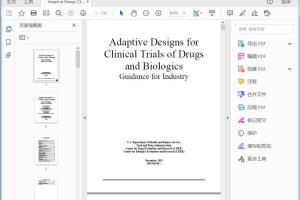
FDA Adaptive Design Clinical Trials for Drugs and Biologics Guidance for Industry
Adaptive Design Clinical Trials for Drugs and Biologics Guidance for Industry[附网盘链接]是FDA于过去发布的FDA标准,适用于美国。本次分享的标准文档为高清PDF(文字版),标准文档内可搜索,可复制,可粘贴。本文结尾附网盘链接。
-

FDA Compliance Policy for the Quantity of Bioavailability and Bioequivalence Samples Retained Under 21 CFR 320.38(c)
Compliance Policy for the Quantity of Bioavailability and Bioequivalence Samples Retained Under 21 CFR 320.38(c)[附网盘链接]是FDA于不久前发布的FDA标准,适用于U.S。本次分享的标准文档为高清PDF(文字版),标准文档内可搜索,可复制,可粘贴。本文结尾附网盘链接。
-

FDA Coronary Drug-Eluting Stents — Nonclinical and Clinical Studies -Companion Document
Coronary Drug-Eluting Stents — Nonclinical and Clinical Studies -Companion Document[附网盘链接]是FDA于当前发布的FDA标准,适用于美国。本次分享的标准文档为高清PDF(文字版),标准文档内可搜索,可复制,可粘贴。本文结尾附网盘链接。
-

FDA Chronic Hepatitis D Virus Infection Developing Drugs for Treatment Guidance for Industry
Chronic Hepatitis D Virus Infection Developing Drugs for Treatment Guidance for Industry[附网盘链接]是Food&Drug Administration于当前发布的FDA标准,适用于United States。本次分享的标准文档为高清PDF(文字版),标准文档内可搜索,可复制,可粘贴。本文结尾附网盘链接。
-

FDA Converting Units of Measure for Folate, Niacin, and Vitamins A, D, and E on the Nutrition and Supplement Facts Labels
Converting Units of Measure for Folate, Niacin, and Vitamins A, D, and E on the Nutrition and Supplement Facts Labels[附网盘链接]是Food And Drug Administration于不久前发布的FDA标准,适用于US。本次分享的标准文档为高清PDF(文字版),标准文档内可搜索,可复制,可粘贴。本文结尾附网盘链接。